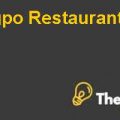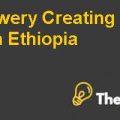
Question # 1
The Cola industry has 2 pioneers the first one being Coca-Cola (1886) followed by Pepsi-Cola (1893) initially being sold as a syrup.The companies deviated from the perceived image of the product and established a sales force and started brand advertisings, which led to new dimensions and possibilities for the product. The companies knew about the potential of the industry and kept the formulas for the syrups as a secret.
Coca-Cola started providingits bottling franchises in 1899 for a nominal one dollar, which opened numerous gates for growth in the industry. Owners believed that the future of the drink rested with soda fountains. The bottling network of Coca Cola soon grew as the franchises increased from 1 to 370 by 1910 whereas;Pepsi Cola had a network of 270 bottlers.
Coca-Cola went public in 1919, which took the industry to a whole new level with more margins for investment and profit margins. From 1920-1930’s,Coke pioneered open-top coolers. The advancement allowed it to enter the grocery markets and other channels as well, which positively affected the revenues, followed by advertising campaigns that were launched .The Cola industry started to display it self as a product for daily usage, rather than being conceived as a syrup from the pharmaceutical.
The Cola business went international after the World War II where every man in a uniform would be given a coke for 5 cents only. 64 new plants were established overseas by the U.S government,which motivated the global acceptance for the product. On the other hand, Pepsi-Cola struggled initially however, the business started to grow as the company lowered the price of its 12-oz bottle to a nickel during the great depression.
Pepsi-Cola had to rely on its small local bottlers to compete with wealthy and established Coke Franchisees. By 1950’s, Coke gathered a market share in the U.S of 47% and Pepsi-Cola had a 10% market share. The remaining shares were of other beverage companies, which produced flavored beverages. The marketing plans and competitive strategies along with the products’ cost of the companies made the industry profitable.
Question # 2
Concentrate Producers & Bottlers:
Manufacturing by concentrate producers required little investment in machinery, labor and overheads. A typical concentrate manufacturing plant, which covers an area as large as the United States costs between $50 million-$100 million, whereas the bottling process was capital intensive and required high speed production lines that was only for similar products or similar packaging. Bottling lines cost from $4 million to $10 million each varying from the quantity and the type of the packaging;how ever a plant with several lines would easily mount up to hundreds of millions of dollars.
Advertising, promotion, market research and bottlers’ support significantly increased the costs for concentrate producers.On the other hand, bottlers’ main costs were of concentrate and syrup and other significant expenses included packaging, labor and overheads.
The U.S soft drink industry witnesseda drastic change over the period of time.Moreover, the concentrate producers of Coke and Pepsi claimed a combined 72% of the U.S CSD market’s sales volume in 2009.
The difference of cost incursions and their focus areas led to a gap between the profitability concentrate producers and bottlers.
Question # 3
Coke and Pepsi battled for the market share of the world’s beverage industry around more than a century. The Colawars were fought over $74 billion carbonated soft drinks (CSD) industry in the U.S. During the struggle from 1975 to 1990’s, both the competitors achieved annual revenue growth of around 10% as the consumption of CSD’s rose steadily year after year.
The Colawar could be perceived as a fight without blood. Pepsi and Coke heavily depend on each other and they would have a tough time being active competitors if any one of them did not exist. The competition of these two rivals proves to be healthy for the industry of CSD. The sharper and successful the competitor is, the more the other company tries to match their standards in a short period of time. Both the companies have played an important role in each other’s originality and success.Since both the companies are large that makes it difficult for other companies to compete with these both companies that affect the profits of the entire industry.Cola War Continues Coke and Pepsi in 2010 Case Solution
Americans consumed 23 gallons of CSD’s annually as the number grew by an average of 3% per year over the next three decades. In addition to this, a market segment of Cola has maintained its dominance within the CSD category. The battle of Pepsi and Coke had helped the CSD industry to gather a 71% market share in 1990, which later on dropped to 55% in 2009. The U.S soft drink industry was heavily affected by Pepsi and Coke.Among other producers, Pepsi and Coke claimed a 72% of market sales volume..............................
This is just a sample partial case solution. Please place the order on the website to order your own originally done case solution.












